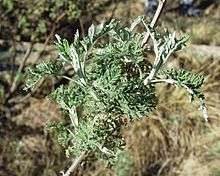Artemisia afra
| Artemisia afra | |
|---|---|
 | |
| African wormwood | |
| Scientific classification | |
| Kingdom: | Plantae |
| (unranked): | Angiosperms |
| (unranked): | Eudicots |
| (unranked): | Asterids |
| Order: | Asterales |
| Family: | Asteraceae |
| Genus: | Artemisia |
| Species: | A. afra |
| Binomial name | |
| Artemisia afra Jacq. ex Willd. | |
| Synonyms[1] | |
| |
Artemisia afra is a common species of the genus Artemisia in Africa, with a wide distribution from South Africa, to areas reaching to the North and East, as far north as Ethiopia. Artemisia afra is the only indigenous species in this genus.
Growth
Artemisia afra grows in clumps, with ridged, woody stems, reaching from 0.5 meters to 2 meters in height. The leaves are dark green, of soft texture, and similar in shape to fern leaves. The undersides of the leaves are a lighter green, and are covered with white bristles. Artemisia afra blossoms in late summer, producing abundant bracts of butter-colored flowers, each approximately 3 to 5 millimeters in diameter. Artemisia afra exudes a pungent, sweet smell when any part of the plant is bruised.
Ethnobiology
Artemisia afra is a well-known medicinal plant in Africa, and is still used by people of many cultures. The roots, stems and leaves are used as enemas, poultices, infusions, lotions, inhaled (e.g. smoked or snuffed), or as an essential oil. In addition, Artemisia afra is frequently used as a moth repellent, and in organic insecticidal sprays.
Essential oil
Essential oil extracts of Artemisia afra are prepared by steam distillation using twigs and blossoms. Extracts contain the following components (via gas chromatography) which are typical of extracts of the Artemisia genus:
- α-thujone 52.9%
- β-thujone 15.07%
- 1,8 cineole 10.66%
- camphor 5.72%
- germacrene 1.60%
- δ-cadinene 1.16%
- α-terpineol 0.96%
- e-chrysanthenyl acetate 0.78%
- camphene 0.71%
- β-pinene 0.51%
- α-pinene 0.46%
- trans-β-ocimene 0.45%
- myrcene 0.22%
Other names
Lanyana represents a Tswana-derived name for Artemisia afra. Other variants include:
- wild wormwood (English)
- African wormwood (English)
- wilde-als (Afrikaans)
- umhlonyane (Xhosa)
- mhlonyane (Zulu)
- lengana (Tswana)
- zengana (Southern Sotho)
- nyumba (Luo)
References
- Bremness, L. The complete book of herbs, Dorling Kindersley, London, 1988.
- Jackson, W. Origins and meanings of names of South African plant genera, Univ. Cape Town, 1990.
- The new Royal Horticultural Society dictionary of gardening, Huxley, A., et al., eds. Macmillan Press, London, 1992.
- Watt, J.M., & Breyer-Brandwijk, M.G. Medicinal and poisonous plants of Southern and Eastern Africa, E. & S. Lvingstone Ltd., Edinburgh and London 1962
- van Wyk, B-E., van Oudtshoorn, B. & Gericke, N. Medicinal plants of South Africa, Briza, Pretoria, 1997.
External links
| Wikispecies has information related to: Artemisia |
| Wikimedia Commons has media related to Artemisia afra. |
- Taxonomy browser (Artemisia afra)
- Artemisia afra information from NPGS/GRIN
- Dressler, S.; Schmidt, M. & Zizka, G. (2014). [http://www.africanplants.senckenberg.de/root/index.php?submitForm=true&page_id=77&searchTextMenue=Artemisia+afra&filterRegionIDs[]=6&filterRegionIDs[]=1&filterRegionIDs[]=2&filterRegionIDs[]=3&filterRegionIDs[]=5 "Artemisia afra"]. African plants – a Photo Guide. Frankfurt/Main: Forschungsinstitut Senckenberg.